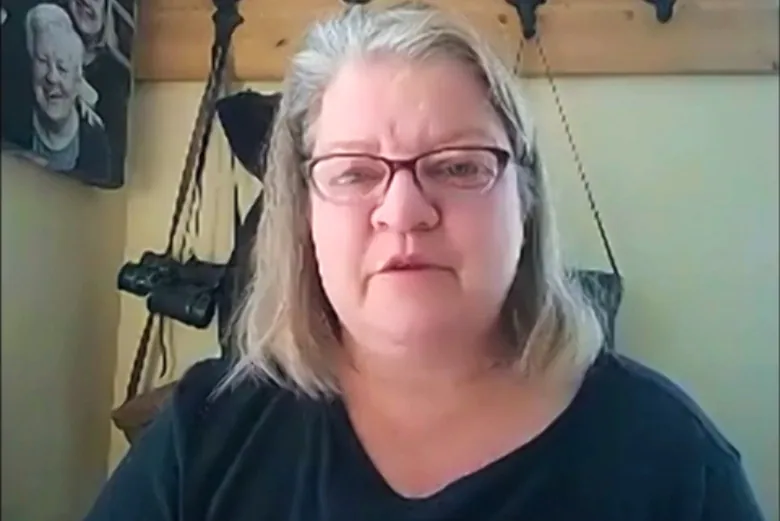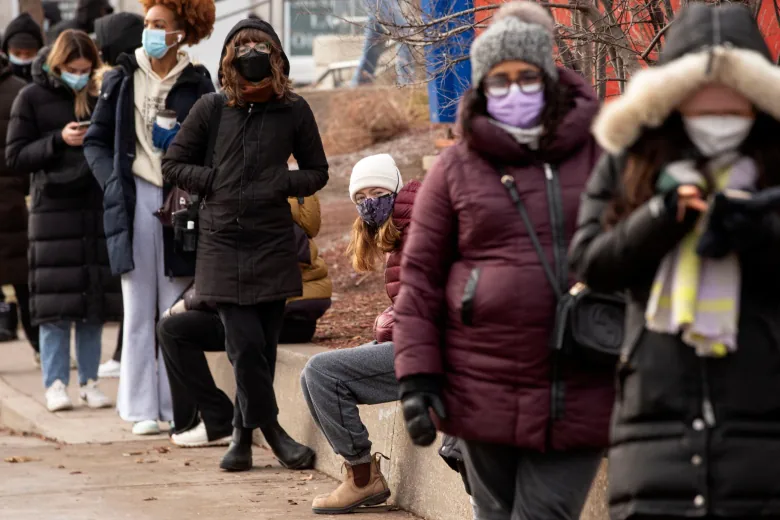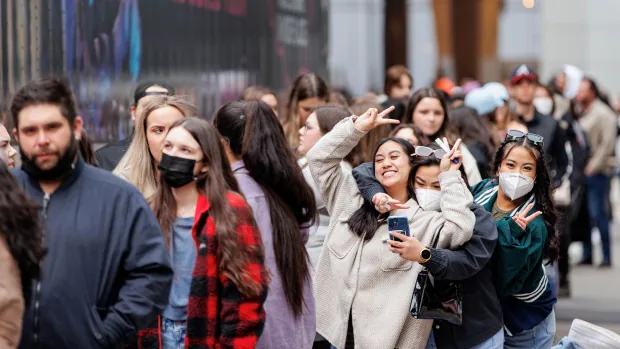Each week, Kalie Hubick joins dozens of others in a Zoom meeting to talk about COVID-19.
Hubick is a disability activist who has a compromised immune system. Other attendees include a retired woman in British Columbia who says she feels abandoned by public health officials, a Toronto cook who wants to keep her co-workers safe and a New Brunswick man whose parents are in long-term care.
All feel they aren’t getting enough accurate information about how much COVID-19 is spreading in their communities to assess their risk. Most provinces — except Quebec and Prince Edward Island — no longer require people to wear masks in stores, restaurants and other indoor public places.
At the same time as the Omicron variant fuels soaring COVID-19 cases, PCR testing has dropped significantly, causing many experts to believe official case counts are dramatic underestimations. As well, some provincial public health officials, including Ontario’s, have cut back on the frequency of their briefings.
Dr. Kieran Moore, Ontario’s chief medical officer of health, hasn’t held a news conference or done any media interviews in four weeks.
“It was Dr. Moore’s choice to end his regular updates as the province entered a new phase of the pandemic,” a spokesperson for Premier Doug Ford said in an emailed response to a Radio-Canada reporter.
“If Dr. Moore changes his mind and wants to make himself available to media again, it is up to him to do so.”
Group working to ‘plug gaps in data’
“It’s very important that there are scientists and health-care professionals who are still there for people,” said Tara Moriarty, an associate professor and infectious disease researcher at the University of Toronto. She co-founded COVID-19 Resources Canada, which hosts the public Zoom sessions every Tuesday and Wednesday evening.
At first, one of the main goals of the group was to provide accurate information about COVID-19 vaccines and give people who were hesitant a safe, non-judgmental place to ask questions of doctors and other health experts who volunteer their time.
But over the last few months, the focus has shifted.

“We’ve really been working to try to sort of plug gaps in data, to try to figure out what’s actually happening [with COVID-19] and provide information that people can use,” Moriarty told CBC News.
Hubick, who lives in Belleville, Ont., said many people with disabilities who are immunocompromised are in despair, because they don’t have the information they need to assess how much risk they’re taking by venturing out.
“We basically can’t leave our homes right now … if people aren’t wearing masks and we have no idea how much community spread is in our individual locations,” Hubick said.
“[Before] I determined whether I could leave my house as by how many people in the community had COVID. If there was a lot of community spread, I stayed home. If it went down low, then I felt like I could go to the grocery store.”

Right now, COVID-19 Resources Canada, which receives funding from the Public Health Agency of Canada, is trying to develop a metric that translates “science speak” into risk information “that is clear and compelling” for the general public, Moriarty said.
Moriarty and her colleagues are designing a tool that would take all of the available information — including wastewater data, which is proving to be helpful in measuring true levels of infection in a community, as well as hospitalizations, COVID deaths, the test positivity rate and estimated daily cases — and calculate the risk level in every province and territory.
It will look something like the “fire hazard wheel” people see when they go camping, Moriarty said, telling the public if the “COVID hazard” is low, moderate, high or extreme. Just as you wouldn’t have a campfire if the hazard level is high, she said, people could adjust their behaviours, such as limiting contacts or wearing masks, based on the COVID-19 hazard level.
People ‘confused’ about what to do
In Peterborough, Ont., the local public health unit has already launched a version of that idea.
“People at this juncture in the pandemic are confused. They know that we’re entering a new phase, but they don’t know what to do. And we want to equip them with the best evidence to make their decisions,” Peterborough’s medical officer of health, Dr. Thomas Pigott, told the CBC’s Matt Galloway in a recent interview on The Current.
“Hearing from our residents, our team felt it was really critical to create a tool that could make residents as informed as possible based on the current evidence in making their own decisions,” Pigott said.
His team developed a “local COVID-19 risk index,” which is updated once a week. Like Moriarty’s hazard wheel, the calculation incorporates local case rates, hospitalizations, deaths, wastewater surveillance, PCR test positivity and rapid antigen test positivity.
The Current23:03How Canadians can assess the ongoing risk of COVID-19
Public health officials in Peterborough, Ont., have created a tool to help people assess the specific COVID-19 risk in that region and protect themselves against the virus. Dr. Thomas Piggott, the medical officer of health for Peterborough Public Health, explains how the tool works. We also discuss what Canadians should consider as cases rise, with infectious disease specialist Dr. Lisa Barrett, and neuroscientist and science communicator Samantha Yammine. 23:03
Because the availability of PCR testing has dropped, Peterborough’s public health unit asks people to fill out a confidential self-report survey on the results of their rapid antigen tests.
Right now, the COVID-19 index shows the risk in the community is high. Pigott said.
“High risk means that there are preventative measures that everyone should continue to be taking,” he told The Current.
“Quite simply, everyone should still be wearing a mask,” he said. “The general public should be wearing them because wearing your mask doesn’t just protect yourself, it does help protect those around you.”
When asked by Galloway if he thought his community had been abandoned by the provincial government, Pigott said he didn’t think it was his position “to comment on provincial government policy.”
The highly contagious Omicron subvariant BA.2 is causing a surge of new COVID-19 infections across Ontario. Health experts are urging the province to reimpose mask mandates so hospitals don’t get overwhelmed again. 1:59
“I’m concerned that we’re rushing to move on from this stage of the pandemic,” he said. “I’m trying to do the best I can so that residents know what they can do to continue to protect not only themselves, but those around them as well.”
Moriarty shares that worry and said that in addition to providing accurate COVID-19 data, her Zoom meetings offer support to people feeling left behind as others rush to embrace the end of pandemic restrictions.
“Part of why we’re doing them is to establish a bit of a sense of community so that people from across the country can meet each other as well and know that … there are other people out there who are worried and concerned.”



